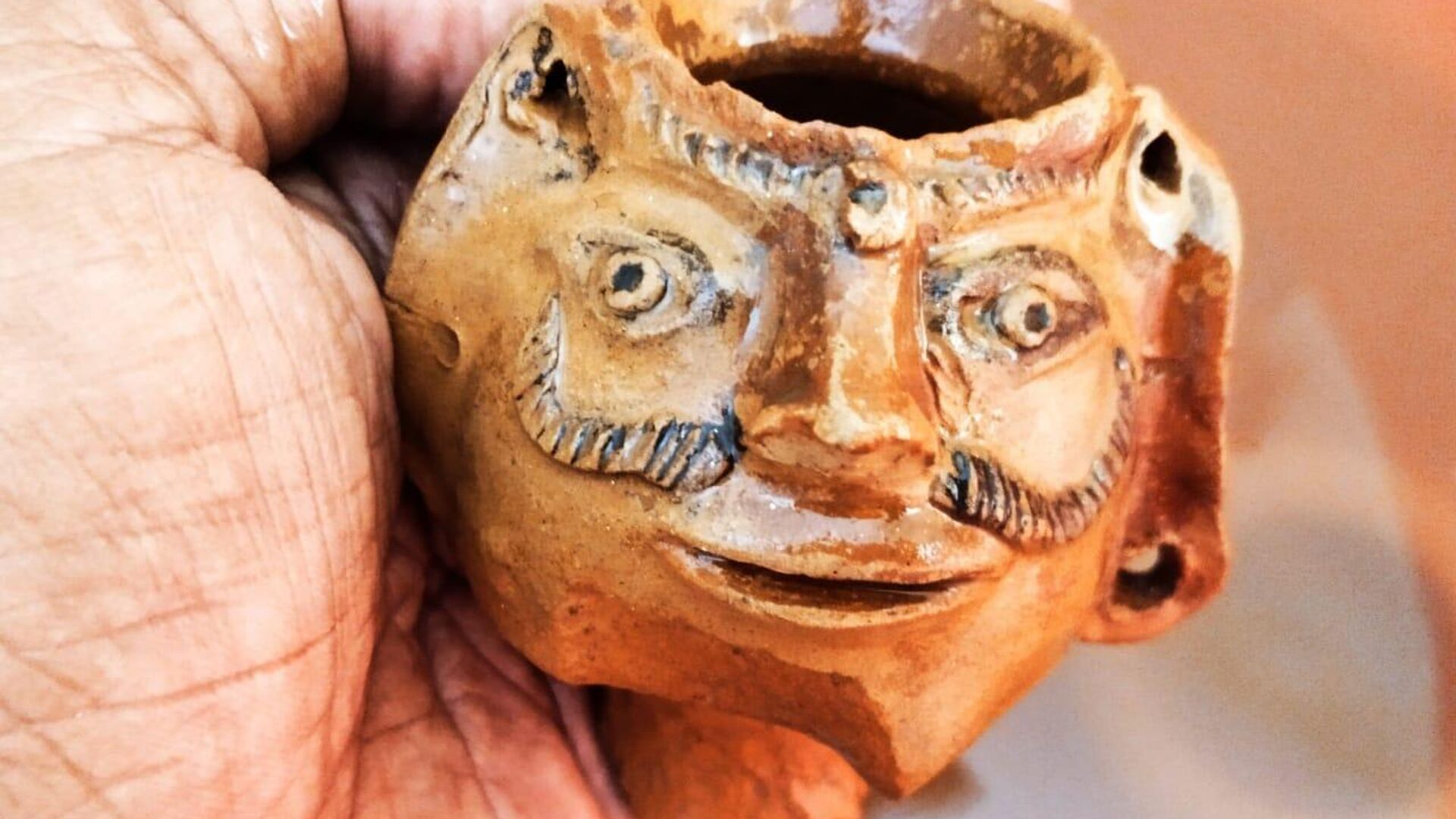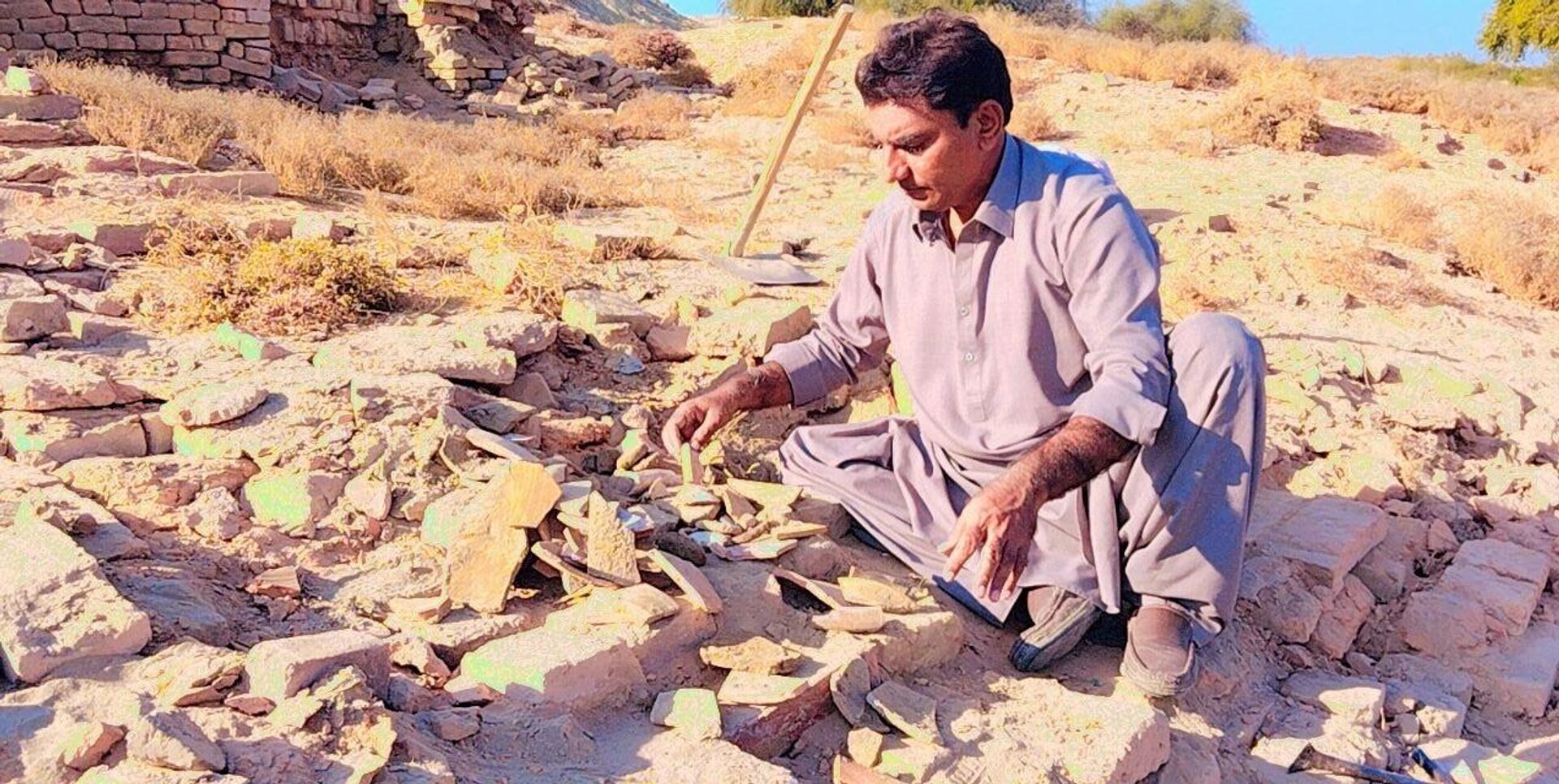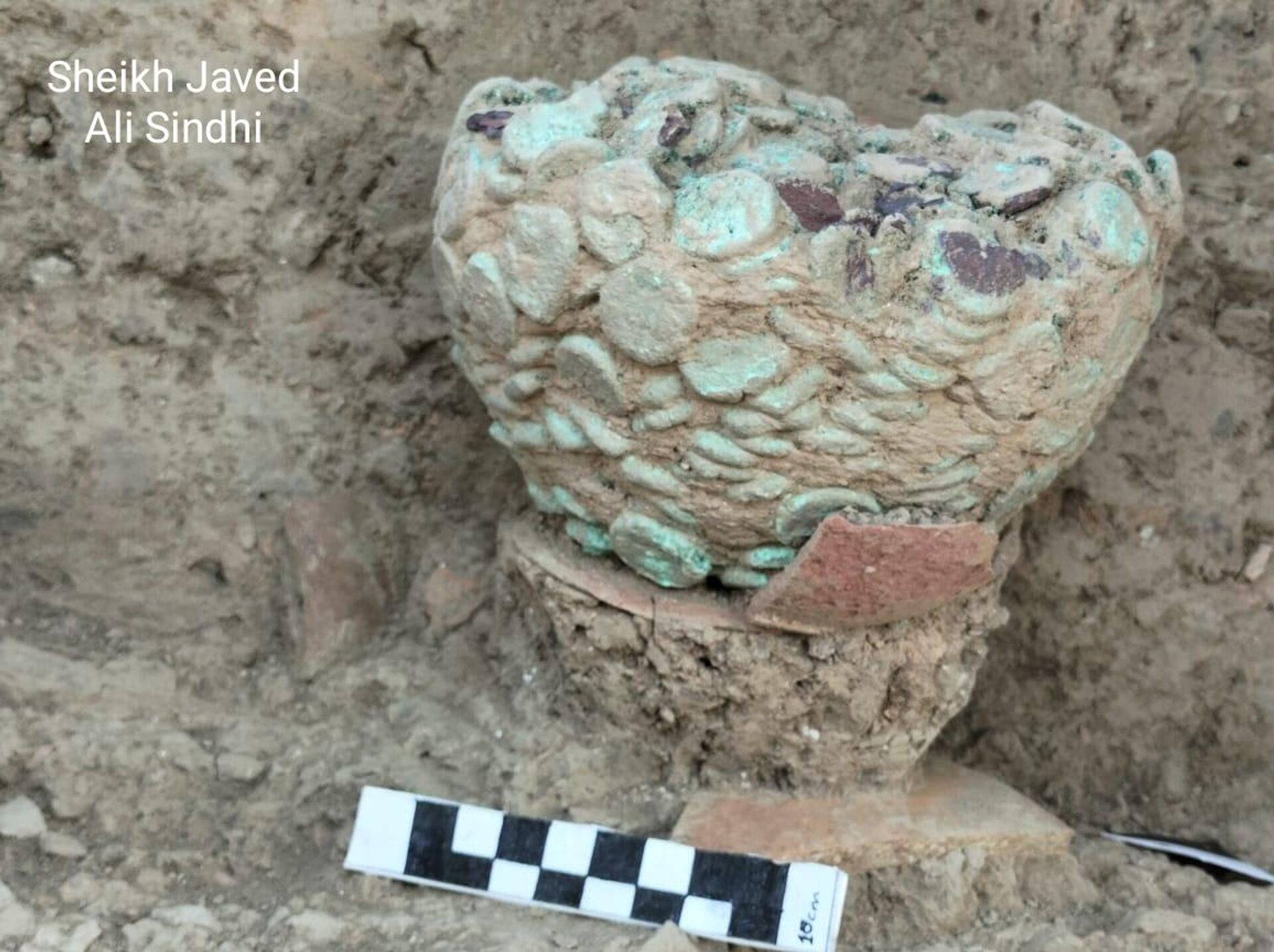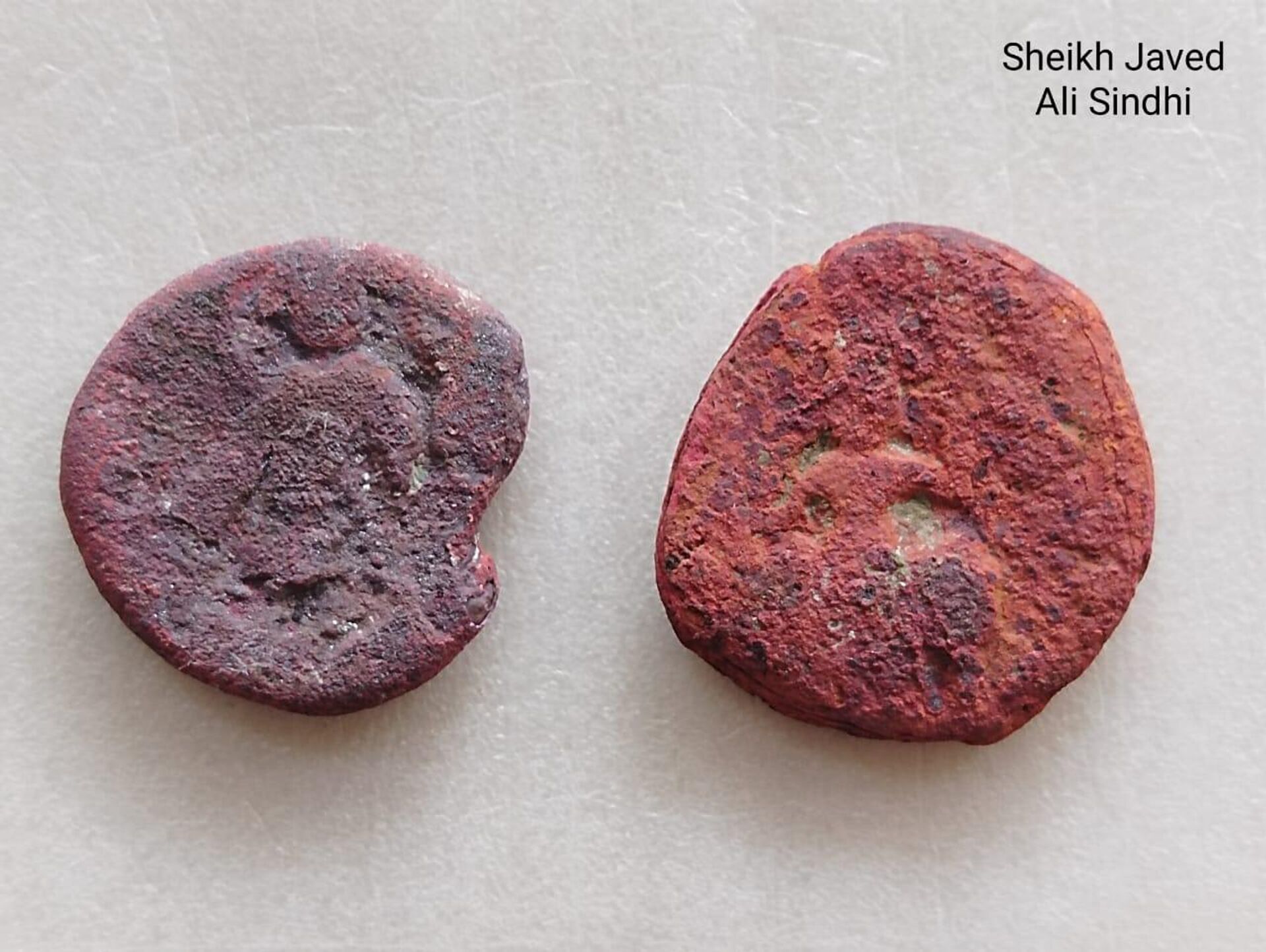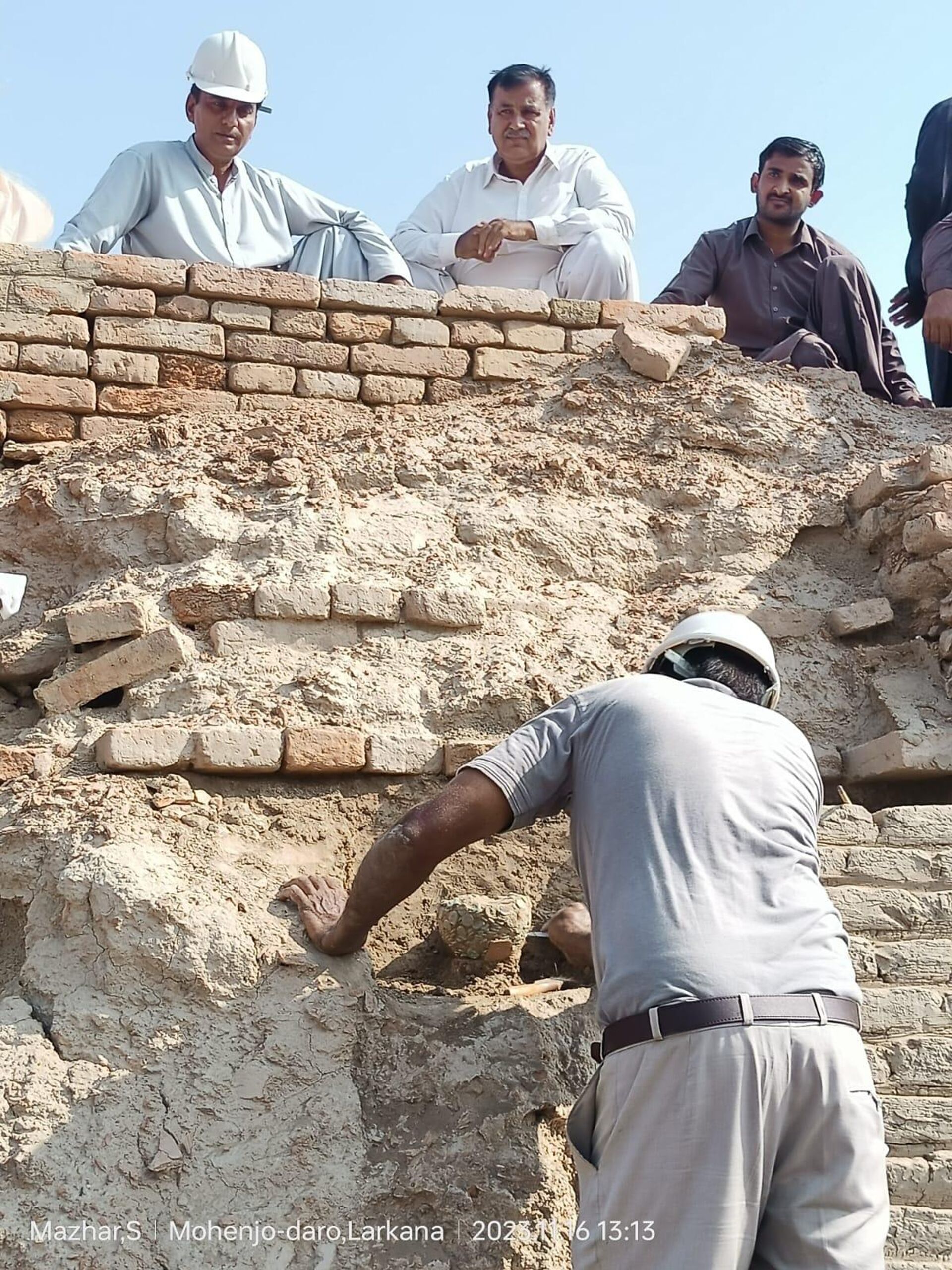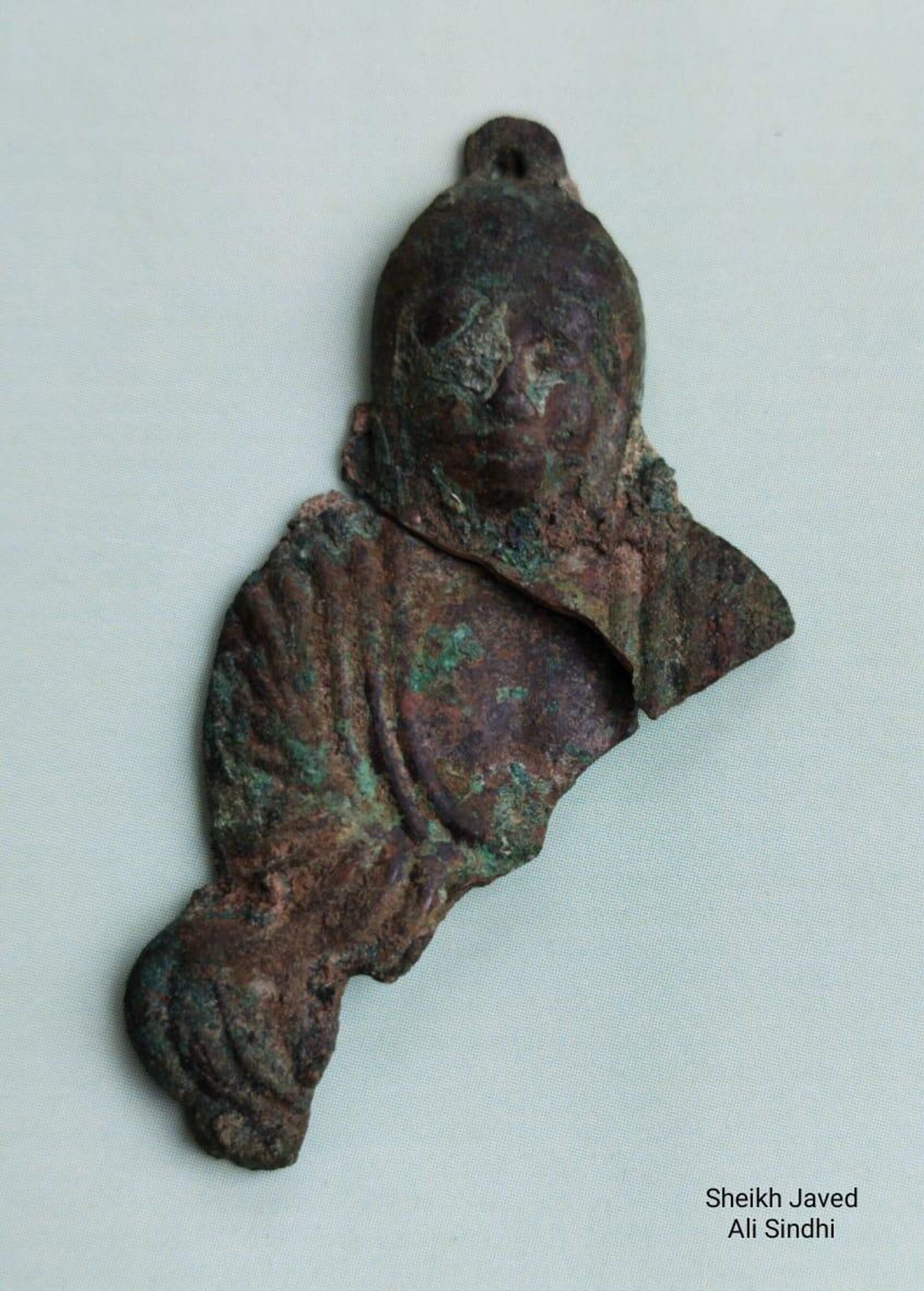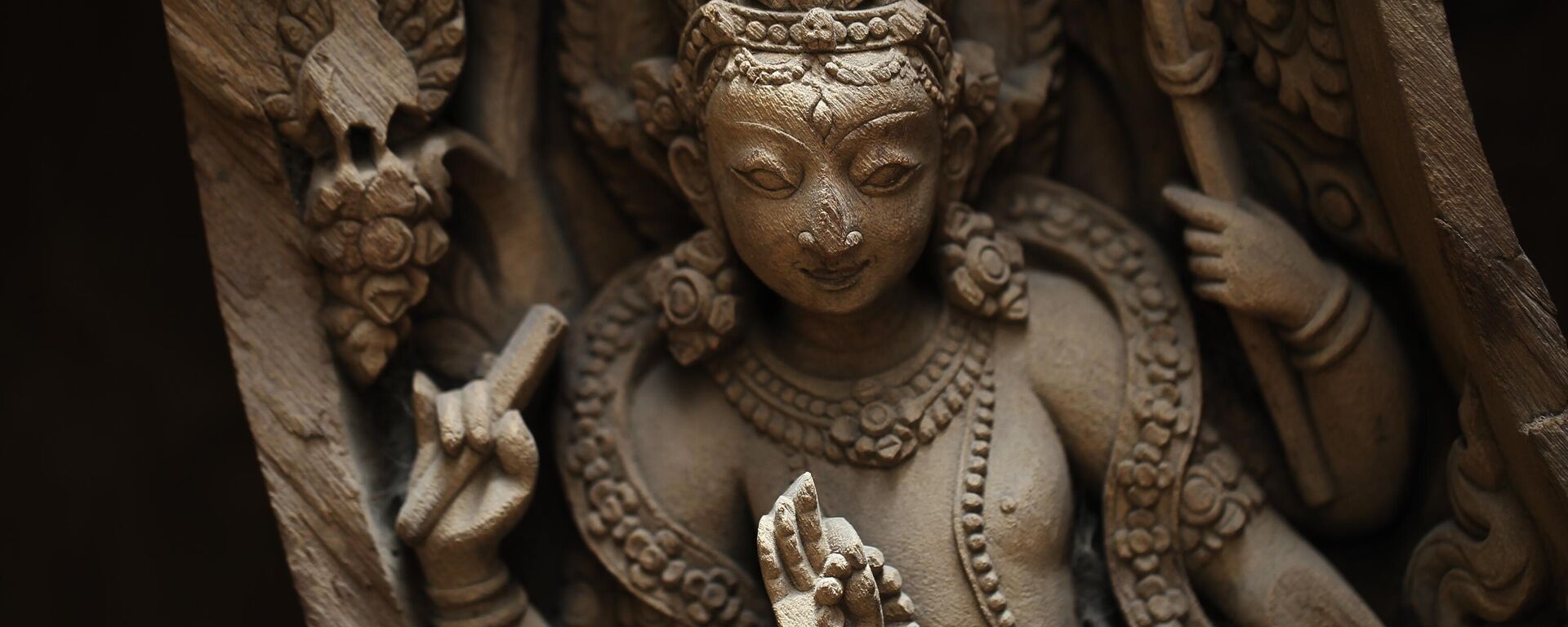https://sputniknews.in/20231218/pakistani-researcher-sheds-light-on-newly-discovered-artifacts-at-mohenjo-daro-5844704.html
Pakistani Researcher Sheds Light on Newly Discovered Artifacts at Mohenjo-Daro
Pakistani Researcher Sheds Light on Newly Discovered Artifacts at Mohenjo-Daro
Sputnik India
A Pakistan-based researcher and tour guide at the Mohenjodaro Archaeological Site and Museum told Sputnik India about the discovery of a 2,000-year-old Kushan coin hoard and other artifacts.
2023-12-18T17:41+0530
2023-12-18T17:41+0530
2023-12-18T17:41+0530
sputnik exclusives
india
science & tech
buddha
pakistan
unesco
balochistan
archaeological sites
buddhism
https://cdn1.img.sputniknews.in/img/07e7/0c/0f/5844896_0:141:1281:861_1920x0_80_0_0_b0bfbd630ec5544caa452323bb5dfd34.jpg
The incessant rains of August 2022 wreaked havoc on the ancient ruins of Mohenjo-Daro, a priceless treasure that holds the title of the world's oldest civilisation.The UNESCO World Heritage Site suffered extensive structural damage as a result.The structures at the Mohenjodaro site were severely affected by the rains, resulting in collapsed walls, holes and erosion of slopes.While excavating the collapsed wall, the archaeologists and their team of workers made an extraordinary discovery: a pot filled to the brim with valuable ancient copper coins from the ancient city.This led to a massive excavation and conservation effort around the stupa, led by the Directorate of Archaeology, Government of Sindh and UNESCO experts.Pakistan-based researcher and guide at the Mohenjodaro Archaeological Site and Museum, Sheikh Javed Ali Sindhi, shares his insights into the ancient discoveries and more.Sputnik: Can you tell us about the discovery of a 2,000-year-old hoard of coins at the site of Mohenjo-Daro?The stash of ancient copper coins was unearthed in a pottery vessel behind chamber 29 A on the west side of the Buddhist stupa at the Mohenjodaro site.According to my research, these coins belong to the Kushan period (1st to 3rd century AD) and were issued by Buddhist kings of the Kushan period, namely Kadaphises, Kanishka I, Huvishka and Vasudeva I, from the 2nd to 5th century AD.Sputnik: What were the main characteristics of these coins?The haul consists of round copper pieces, thinner in shape. On their backs were Siva, a bull, a thorn goddess, a nimble figure, a trident, the cross, a series of pellets and fire altars.Previously, a large number of copper coins belonging to King Vasudeva I had been found in the Buddhist monastery at Mohenjodaro. But it seems that this recently unearthed (November 2023) hoard of coins was deposited in the monks' cells during the reign of King Kanishka II, who ruled from 230 to 247 AD.His coins depict Kanishka II standing with a trident above him and a fire altar on the obverse. The reverse shows Ardochsho seated on a throne.Trade and commerce were at its peak during the Kushan Kings of India and these copper coins, called drachmas, were minted until 230 AD for internal trade and economic activities. Gold coins were used for international trade.Sputnik: What are some of the other findings from the excavations at the Mohanjodaro site?After the heavy monsoon rains of August 2022, we found several artifacts such as a bronze Buddha pendant, a human-headed vessel and some burnt brick structures.The burnt brick structures were thought to be similar to citadel watchtowers excavated by Sir Mortimer Wheeler in the 1950s to the south-east of Stupa Hill. The bricks date from the Harrapan period (2600-1900 BC).During the excavation, we also found pieces of terracotta bracelets, potsherds, pieces of touchstones, shells, cones, trefoils in shells, balls, bones and other antiquities. Other important discoveries besides the watchtowers are the passage and the floor.Sputnik: How have recent discoveries added to our knowledge of the rich history of the ancient Indus Valley/Harappan civilisation?The discovery of a hoard of copper coins will shed new light on Buddhism in Sindh.Moreover, the discovery of watchtowers in the citadel area clarifies our ideas about fortification walls and their defensive system. We can easily understand the technology of warfare and weaponry in the 3rd millennium BC.Previously it was thought that the people of the Indus Valley civilisation were peaceful traders and merchants, but there is no evidence of mass weapons of war. But the discovery of these watchtowers at Mohenjodaro has shed new light on fortification.Sputnik: What are your plans and aspirations?I want to explore the Indus sites in the neighbouring districts of Sindh, including the border with Balochistan, because these areas are considered hidden from the outside world.We need to work on the Indus script, which has not been deciphered or fully decoded, and also explore bilingual texts for deciphering the Indus script.We should take help from Sumerian cuneiform tablets to decipher the Meluhhan language spoken within the Indus Valley civilisation. We must encourage young scholars to study the Indus Valley civilisation.
https://sputniknews.in/20231208/indias-archaeologists-to-survey-1500-year-old-hindu-buddhist-sculptures-5763332.html
india
pakistan
balochistan
Sputnik India
feedback.hindi@sputniknews.com
+74956456601
MIA „Rossiya Segodnya“
2023
Sangeeta Yadav
https://cdn1.img.sputniknews.in/img/07e6/0c/0f/110602_0:0:641:640_100x100_80_0_0_c298016a79eb02ef8caa9d1f688c12a5.jpg
Sangeeta Yadav
https://cdn1.img.sputniknews.in/img/07e6/0c/0f/110602_0:0:641:640_100x100_80_0_0_c298016a79eb02ef8caa9d1f688c12a5.jpg
News
en_IN
Sputnik India
feedback.hindi@sputniknews.com
+74956456601
MIA „Rossiya Segodnya“
Sputnik India
feedback.hindi@sputniknews.com
+74956456601
MIA „Rossiya Segodnya“
Sangeeta Yadav
https://cdn1.img.sputniknews.in/img/07e6/0c/0f/110602_0:0:641:640_100x100_80_0_0_c298016a79eb02ef8caa9d1f688c12a5.jpg
pakistani researcher, ancient discoveries, mohenjo-daro, research scholar, tourist guide, mohenjodaro archaeological site and museum, 2,000-year-old kushan coin hoard, artifacts, incessant rainfall, ancient ruins of mohenjo-daro, treasure, oldest civilization in the world, unesco world heritage site, collapsed walls, erosion of slopes, archaeologists, discovery, antique copper coins, ancient city, excavation, conservation, stupa, directorate of archaeology, government of sindh, unesco, sheikh javed ali sindhi, 2,000-year-old coin hoard, pottery vessel, buddhist stupa, kushan period, buddhist kings of kushan period, kadaphises, kanishka i, huvishka, vasudeva i, king vasudeva i, buddhist monastery of mohenjodaro, monk’s cells, reign of king kanishka ii, kushan kings of india, drachma, internal trades, economic activities, international trade, bronze pendent of buddha, a human-headed vessel, burnt brick structures, heavy monsoon rains, burnt brick, citadel, watch towers sir mortimer wheeler, stupa, harrapan period, terracotta bangle pieces, potsherds, touchstones pieces, shells, cones, trefoil in shell, balls, bones, antiquities, passage, floor, ancient indus valley, harappan civilization, buddhism in sindh, fortification walls, defensive system, warfare, weaponry, millennium bce, indus valley civilization, balochistan, border, indus script, deciphered, decoded bilingual text, sumerian cuneiform tablets, meluhhan language
pakistani researcher, ancient discoveries, mohenjo-daro, research scholar, tourist guide, mohenjodaro archaeological site and museum, 2,000-year-old kushan coin hoard, artifacts, incessant rainfall, ancient ruins of mohenjo-daro, treasure, oldest civilization in the world, unesco world heritage site, collapsed walls, erosion of slopes, archaeologists, discovery, antique copper coins, ancient city, excavation, conservation, stupa, directorate of archaeology, government of sindh, unesco, sheikh javed ali sindhi, 2,000-year-old coin hoard, pottery vessel, buddhist stupa, kushan period, buddhist kings of kushan period, kadaphises, kanishka i, huvishka, vasudeva i, king vasudeva i, buddhist monastery of mohenjodaro, monk’s cells, reign of king kanishka ii, kushan kings of india, drachma, internal trades, economic activities, international trade, bronze pendent of buddha, a human-headed vessel, burnt brick structures, heavy monsoon rains, burnt brick, citadel, watch towers sir mortimer wheeler, stupa, harrapan period, terracotta bangle pieces, potsherds, touchstones pieces, shells, cones, trefoil in shell, balls, bones, antiquities, passage, floor, ancient indus valley, harappan civilization, buddhism in sindh, fortification walls, defensive system, warfare, weaponry, millennium bce, indus valley civilization, balochistan, border, indus script, deciphered, decoded bilingual text, sumerian cuneiform tablets, meluhhan language
The incessant rains of August 2022 wreaked havoc on the ancient ruins of Mohenjo-Daro, a priceless treasure that holds the title of the world's oldest civilisation.
The UNESCO World Heritage Site suffered extensive structural damage as a result.
The structures at the Mohenjodaro site were severely affected by the rains, resulting in collapsed walls, holes and erosion of slopes.
While excavating the collapsed wall, the archaeologists and their team of workers made an extraordinary discovery: a pot filled to the brim with valuable ancient copper coins from the ancient city.
This led to a
massive excavation and conservation effort around the stupa, led by the Directorate of Archaeology, Government of Sindh and UNESCO experts.
Pakistan-based researcher and guide at the Mohenjodaro Archaeological Site and Museum, Sheikh Javed Ali Sindhi, shares his insights into the ancient discoveries and more.
Sputnik: Can you tell us about the discovery of a 2,000-year-old hoard of coins at the site of Mohenjo-Daro?
The stash of ancient copper coins was unearthed in a pottery vessel behind chamber 29 A on the west side of the Buddhist stupa at the Mohenjodaro site. According to my research, these coins belong to the Kushan period (1st to 3rd century AD) and were issued by Buddhist kings of the Kushan period, namely Kadaphises, Kanishka I, Huvishka and Vasudeva I, from the 2nd to 5th century AD.
Sputnik: What were the main characteristics of these coins?
The haul consists of round copper pieces, thinner in shape. On their backs were Siva, a bull, a thorn goddess, a nimble figure, a trident, the cross, a series of pellets and fire altars.
Previously, a large number of copper coins belonging to King Vasudeva I had been found in the Buddhist monastery at Mohenjodaro. But it seems that this recently unearthed (November 2023) hoard of coins was deposited in the monks' cells during the reign of King Kanishka II, who ruled from 230 to 247 AD.
His coins depict Kanishka II standing with a trident above him and a fire altar on the obverse. The reverse shows Ardochsho seated on a throne.
Trade and commerce were at its peak during the Kushan Kings of India and these copper coins, called drachmas, were minted until 230 AD for
internal trade and economic activities. Gold coins were used for international trade.
Sputnik: What are some of the other findings from the excavations at the Mohanjodaro site?
After the heavy monsoon rains of August 2022, we found
several artifacts such as a bronze
Buddha pendant, a human-headed vessel and some burnt brick structures.
The burnt brick structures were thought to be similar to citadel watchtowers excavated by Sir Mortimer Wheeler in the 1950s to the south-east of Stupa Hill. The bricks date from the Harrapan period (2600-1900 BC).
During the excavation, we also found pieces of terracotta bracelets, potsherds, pieces of touchstones, shells, cones, trefoils in shells, balls, bones and other antiquities. Other important discoveries besides the watchtowers are the passage and the floor.
Sputnik: How have recent discoveries added to our knowledge of the rich history of the ancient Indus Valley/Harappan civilisation?
The discovery of a hoard of copper coins will shed new light on Buddhism in Sindh.
Moreover, the discovery of watchtowers in the citadel area clarifies our ideas about fortification walls and their defensive system. We can easily understand the technology of warfare and weaponry in the 3rd millennium BC.
Previously it was thought that the people of the Indus Valley civilisation were peaceful traders and merchants, but there is no evidence of mass weapons of war. But the discovery of these watchtowers at Mohenjodaro has shed new light on fortification.
Sputnik: What are your plans and aspirations?
I want to explore the Indus sites in the neighbouring districts of Sindh, including the border with Balochistan, because these areas are considered hidden from the outside world.
We need to work on the Indus script, which has not been deciphered or fully decoded, and also explore bilingual texts for deciphering the Indus script.
We should take help from Sumerian cuneiform tablets to decipher the Meluhhan language spoken within the Indus Valley civilisation. We must encourage young scholars to study the Indus Valley civilisation.
